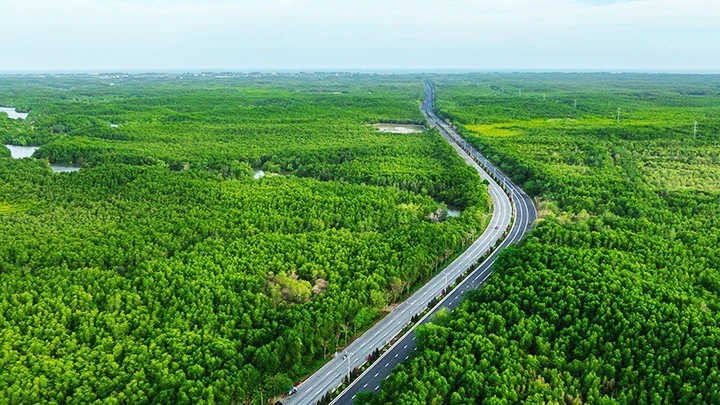Development of transport infrastructure towards the sea accelerated
Alongside the development of the nearly 3,000-hectare Can Gio Coastal Tourism Urban Area, Ho Chi Minh City is ramping up the planning and construction of key transport infrastructure projects, including bridges, roads, and metro lines, toward the sea, aiming to become a large-scale coastal megacity.

From roads and bridges...
The Ho Chi Minh City People’s Committee has recently submitted a proposal to the Prime Minister to adjust the city’s master plan through 2040, with a vision toward 2060. Among the key projects is the southern coastal road, part of a planned 940-kilometre coastal traffic corridor running through nine southern provinces and cities. The section passing through Ho Chi Minh City will begin at National Highway 50, cross the Soai Rap River connect to the Can Gio International Transshipment Port and Phuoc An Port, and extend to the Ben Luc–Long Thanh Expressway.
Once completed, this route is expected to become a vital coastal economic corridor, driving the development of the Can Gio Coastal Tourism Urban Area and enabling efficient use of seaport systems such as Can Gio and Cai Mep–Thi Vai. It will also enhance economic and transport connectivity between Ho Chi Minh City and neighbouring provinces.
According to Dr. Pham Viet Thuan, Director of the Institute for Natural Resources and Environmental Economics in Ho Chi Minh City, the coastal road will be a key driver for socio-economic and tourism development, both locally and regionally, while also opening new urban spaces oriented toward the sea. “When implementing this coastal section, it is crucial to thoroughly survey the terrain and geological conditions, as the area is complex, with many swamps, rivers, and canals. At the same time, it is essential to carefully assess feasibility and identify appropriate investment methods, given the substantial costs involved,” Dr. Thuan noted.
However, the Can Gio region remains somewhat isolated, heavily reliant on the Binh Khanh Ferry, which poses a major bottleneck to the city’s efforts to expand seaward. “Although it’s just a river separating us, we still have to take the ferry, and each crossing takes about 30 minutes—sometimes even an hour—to get to Nha Be. It is very inconvenient. For generations, we residents of Can Gio have longed for a bridge over the river,” shared Mr. Do Van Hen (67 years old, a Can Gio local) as he waited on his motorbike at the Binh Khanh Ferry terminal. He added that although he has witnessed tremendous changes in the area over his lifetime, one lingering concern for himself and his neighbors has always been the long-awaited Can Gio Bridge.
After many years of anticipation, Ho Chi Minh City is now taking the final steps toward investing in the construction of the Can Gio Bridge, offering new hope for seamless and convenient regional connectivity with the city centre.
Commenting on the matter, Acting Director of the City Department of Construction Tran Quang Lam, stated that once completed, the Can Gio Bridge will replace the Binh Khanh Ferry and reduce travel time from the city center to Can Gio to just 30–45 minutes. The city plans to implement the project during the 2025–2028 period.
...and to metro
Recently, Vingroup submitted a proposal to the Ho Chi Minh City People’s Committee, the Department of Construction, and other relevant local authorities, requesting permission to conduct geological surveys in preparation for designing a metro line connecting the city centre with Can Gio area. Earlier, in May, the Ho Chi Minh City People’s Committee had approved Vingroup’s request to study and prepare a project proposal for this metro line under a public-private partnership (PPP) model.
The proposed urban railway project is expected to span approximately 48.7 kilometres. The line would begin at Nguyen Van Linh Street, follow the Nguyen Luong Bang–Rung Sac corridor, and terminate at a 39-hectare plot adjacent to the Can Gio coastal urban development area. According to the investor’s proposal, project preparation would begin in 2025, followed by construction from 2026 to 2028, with trial operations and handover planned for 2028.
Dr. Vo Kim Cuong, former Deputy Director of Ho Chi Minh City Department of Planning and Architecture, expressed his belief that building a metro line from the city centre to Can Gio will strongly boost the development of eco-tourism and coastal urbanisation. He noted that the project promises to be a major driver for socio-economic development in the southern part of the city. In addition, it will help ease road traffic congestion, improve transport infrastructure, enhance connectivity, and raise the quality of life for residents.
Urban planning experts suggest that the merger of Ho Chi Minh City, Binh Duong Province which excels in industry, urban development, and logistics, and Ba Ria–Vung Tau Province with its deep-sea ports and coastal tourism would provide a practical opportunity for the city to expand toward the sea. This merger offers not only access to deep-water maritime space but also the necessary infrastructure and logistics economy. It would help establish a seamless chain of urban centres, industrial zones, ports, and services, mirroring the models currently adopted in cities like Shanghai (China), Singapore, and Bangkok (Thailand).








